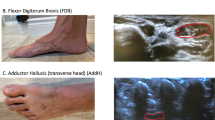Abstract
Sensory feedback from the foot sole plays an important role in shaping human locomotion. While net muscle activity and kinematic changes have been correlated with electrical stimulation to five topographical regions of the foot, it remains unknown if these responses are similar with tactile stimulation. The purpose of this study was to use texture in foot orthosis design, applied to five distinct regions under the foot sole, and measure joint kinematics, location of center of pressure, and muscle activity of eight lower leg muscles during level and incline walking. Fifty-five healthy adults completed 48 walking trials in textured and non-textured foot orthoses. Study results confirm that tactile stimulation is stimulation-site and gait-phase specific in modulating lower leg muscle activity during walking. For example, texture under the lateral forefoot consistently generated a suppression of EMG and texture under the lateral midfoot always generated a facilitation. In early stance, adding texture under the medial midfoot or calcaneus facilitated extensor muscle activity and suppressed flexor muscle activity. Texture under the lateral midfoot or medial forefoot facilitated tibialis posterior activation. These results support the topographical organization of cutaneous mechanoreceptors in foot sole skin while considering how texture can be used in foot orthosis design to target lower leg muscular changes during locomotion.







Similar content being viewed by others
Availability of data and materials
All data generated or analysed during this study area available from the corresponding author on reasonable request.
References
Akuzawa H, Imai A, Iizuka S et al (2016) Calf muscle activity alteration with foot orthoses insertion during walking measured by fine-wire electromyography. J Phys Ther Sci 28:3458–3462. https://doi.org/10.1589/jpts.28.3458
Barn R, Brandon M, Rafferty D et al (2014) Kinematic, kinetic and electromyographic response to customized foot orthoses in patients with tibialis posterior tenosynovitis, pes plano valgus and rheumatoid arthritis. Rheumatology 53:123–130. https://doi.org/10.1093/rheumatology/ket337
Côté MP, Murray LM, Knikou M (2018) Spinal control of locomotion: individual neurons, their circuits and functions. Front Physiol 9:1–27. https://doi.org/10.3389/fphys.2018.00784
de Morais BC, Bértolo MB, Gaino JZ et al (2018) The effect of flat and textured insoles on the balance of primary care elderly people: a randomized controlled clinical trial. Clin Interv Aging 13:277–284. https://doi.org/10.2147/CIA.S149038
Fallon JB, Bent LR, McNulty PA, Macefield VG (2005) Evidence for strong synaptic coupling between single tactile afferents from the sole of the foot and motoneurons supplying leg muscles. J Neurophysiol 94:3795–3804. https://doi.org/10.1152/jn.00359.2005
Garbalosa JC, Elliott B, Feinn R, Wedge R (2015) The effect of orthotics on intersegmental foot kinematics and the EMG activity of select lower leg muscles. Foot 25:206–214. https://doi.org/10.1016/j.foot.2015.07.005
Hatton AL, Dixon J, Rome K, Martin D (2011) Standing on textured surfaces: effects on standing balance in healthy older adults. Age Ageing 40:363–368. https://doi.org/10.1093/ageing/afr026
Hatton AL, Dixon J, Rome K et al (2012) Altering gait by way of stimulation of the plantar surface of the foot: the immediate effect of wearing textured insoles in older fallers. J Foot Ankle Res 5:O21. https://doi.org/10.1186/1757-1146-5-S1-O21
Hermens H, Freriks B, Merletti R et al (1999) SENIAM - European recommendations for surface electromyography. Roessingh Res Dev 8(2):13–54
Hollins M, Bensmaa SJ, Roy EA (2002) Vibrotaction and texture perception. Behav Brain Res 135:51–56. https://doi.org/10.1016/S0166-4328(02)00154-7
Johnson KO (2001) The roles and functions of cutaneous mechanoreceptors. Curr Opin Neurobiol 11:455–461
Kenny RPW, Atkinson G, Eaves DL et al (2019) The effects of textured materials on static balance in healthy young and older adults: a systematic review with meta-analysis. Gait Posture 71:79–86. https://doi.org/10.1016/j.gaitpost.2019.04.017
Kohls-Gatzoulis J, Angel JC, Singh D et al (2004) Tibialis posterior dysfunction: a common and treatable cause of adult acquired flatfoot. Br Med J 329:1328–1333. https://doi.org/10.1136/bmj.329.7478.1328
Komiyama T, Zehr EP, Stein RB (2000) Absence of nerve specificity in human cutaneous reflexes during standing. Exp Brain Res 133:267–272. https://doi.org/10.1007/s002210000411
Li PL, Yick KL, Ng SP, Yip J (2019) Influence of textured indoor footwear on posture stability of older women based on center-of-pressure measurements. Hum Factors 61:1247–1260. https://doi.org/10.1177/0018720819837414
Maharaj JN, Cresswell AG, Lichtwark GA (2016) The mechanical function of the tibialis posterior muscle and its tendon during locomotion. J Biomech 49:3238–3243. https://doi.org/10.1016/j.jbiomech.2016.08.006
Maki BE, Perry SD, Nome RG, Mcllroy WE (1999) Effect of facilitation of sensation from plantar foot-surface boundaries on postural stabilization in young and older adults. J Gerontol Ser A Biol Sci Med Sci 54:281–287. https://doi.org/10.1093/gerona/54.6.M281
Murley GS, Landorf KB, Menz HB (2010) Do foot orthoses change lower limb muscle activity in flat-arched feet towards a pattern observed in normal-arched feet? Clin Biomech 25:728–736. https://doi.org/10.1016/j.clinbiomech.2010.05.001
Nakajima T, Sakamoto M, Tazoe T et al (2006) Location specificity of plantar cutaneous reflexes involving lower limb muscles in humans. Exp Brain Res 175:514–525. https://doi.org/10.1007/s00221-006-0568-6
Nurse MA, Hulliger M, Wakeling JM et al (2005) Changing the texture of footwear can alter gait patterns. J Electromyogr Kinesiol 15:496–506. https://doi.org/10.1016/j.jelekin.2004.12.003
Palluel E, Nougier V, Olivier I (2008) Do spike insoles enhance postural stability and plantar-surface cutaneous sensitivity in the elderly? Age (omaha) 30:53–61. https://doi.org/10.1007/s11357-008-9047-2
Palluel E, Olivier I, Nougier V (2009) The lasting effects of spike insoles on postural control in the elderly. Behav Neurosci 123:1141–1147. https://doi.org/10.1037/a0017115
Pearcey GEP, Zehr EP (2019) We are upright-walking cats: human limbs as sensory antennae during locomotion. Physiology 34:354–364. https://doi.org/10.1152/physiol.00008.2019
Perotto A (2011) Anatomical guide for the electromyographer—the limbs and trunk, fifth. Charles C Thomas, Springfield, Illinois
Perry SD, Radtke A, McIlroy WE et al (2008) Efficacy and effectiveness of a balance-enhancing insole. J Gerontol 63A:595–602
Purves D, Augustine GJ, Fitzpatrick D et al (2018) Lower motor neuron circuits and motor control. Neuroscience, 6th edn. Oxford University Press, United States of America, pp 357–379
Reeves J, Starbuck C, Nester C (2020) EMG gait data from indwelling electrodes is attenuated over time and changes independent of any experimental effect. J Electromyogr Kinesiol 54:102461
Richard MA, Spaich EG, Serrao M, Andersen OK (2015) Stimulation site and phase modulation of the withdrawal reflex during gait initiation. Clin Neurophysiol 126:2282–2289. https://doi.org/10.1016/j.clinph.2015.01.019
Ritchie C, Paterson K, Bryant AL et al (2011) The effects of enhanced plantar sensory feedback and foot orthoses on midfoot kinematics and lower leg neuromuscular activation. Gait Posture 33:576–581. https://doi.org/10.1016/j.gaitpost.2011.01.012
Robb KA, Perry SD (2019) Textured foot orthotics on dynamic stability and turning performance in Parkinson’s disease. J Mot Behav. https://doi.org/10.1080/00222895.2019.1639609
Semple R, Murley GS, Woodburn J, Turner DE (2009) Tibialis posterior in health and disease: a review of structure and function with specific reference to electromyographic studies. J Foot Ankle Res 2:1–8. https://doi.org/10.1186/1757-1146-2-24
Sheffield F, Gersten J, Mastellone A (1956) Electromyographic study of the muscles of the foot in normal walking. Am J Phys Med 35:223–236
Spaich EG, Emborg J, Collet T et al (2009) Withdrawal reflex responses evoked by repetitive painful stimulation delivered on the sole of the foot during late stance: site, phase, and frequency modulation. Exp Brain Res 194:359–368. https://doi.org/10.1007/s00221-009-1705-9
Strzalkowski NDJ, Peters RM, Inglis JT, Bent LR (2018) Cutaneous afferent innervation of the human foot sole: what can we learn from single-unit recordings? J Neurophysiol 120:1233–1246. https://doi.org/10.1152/jn.00848.2017
Van Wezel BMH, Ottenhoff FAM, Duysens J (1997) Dynamic control of location-specific information in tactile cutaneous reflexes from the foot during human walking. J Neurosci 17:3804–3814
Viseux FJF (2020) The sensory role of the sole of the foot: Review and update on clinical perspectives. Neurophysiol Clin 50:55–68. https://doi.org/10.1016/j.neucli.2019.12.003
Weber AI, Saal HP, Lieber JD et al (2013) Spatial and temporal codes mediate the tactile perception of natural textures. Proc Natl Acad Sci U S A 110:17107–17112. https://doi.org/10.1073/pnas.1305509110
Whittle MW (1996) Clinical gait analysis: a review. Hum Mov Sci 15:369–387. https://doi.org/10.1016/0167-9457(96)00006-1
Whittle MW (2007) Normal gait. In: Gait analysis: an introduction, fourth. Butterworth Heinemann Elsevier, Philadelphia, PA, pp 47–100
Wilkinson M, Ewen A, Caplan N et al (2018) Textured insoles reduce vertical loading rate and increase subjective plantar sensation in overground running. Eur J Sport Sci 18:497–503. https://doi.org/10.1080/17461391.2018.1444094
Wilson ML, Rome K, Hodgson D, Ball P (2008) Effect of textured foot orthotics on static and dynamic postural stability in middle-aged females. Gait Posture 27:36–42. https://doi.org/10.1016/j.gaitpost.2006.12.006
Zehr EP, Stein RB (1999) What functions do reflexes serve during human locomotion? Prog Neurobiol 58:185–205. https://doi.org/10.1016/S0301-0082(98)00081-1
Zehr EP, Komiyama T, Stein RB (1997) Cutaneous reflexes during human gait: electromyographic and kinematic responses to electrical stimulation. J Neurophysiol 77:3311–3325. https://doi.org/10.1152/jn.1997.77.6.3311
Zehr EP, Fujita K, Stein RB (1998a) Reflexes from the superficial peroneal nerve during walking in stroke subjects. J Neurophysiol 79:848–858. https://doi.org/10.1152/jn.1998.79.2.848
Zehr EP, Stein RB, Komiyama T (1998b) Function of sural nerve reflexes during human walking. J Physiol 507:305–314. https://doi.org/10.1111/j.1469-7793.1998.305bu.x
Zehr EP, Stein RB, Komiyama T (1998c) Non-noxious electrical stimulation of cutaneous nerves during human walking. J Physiol 1:10
Zehr EP, Nakajima T, Barss T et al (2014) Cutaneous stimulation of discrete regions of the sole during locomotion produces “sensory steering” of the foot. BMC Sports Sci Med Rehabil 6:1–23. https://doi.org/10.1186/2052-1847-6-33
Funding
This work was supported by the Pedorthic Research Foundation of Canada, the Natural Science and Engineer Research Council of Canada (NSERC) Discovery Grant [RGPIN-2015-06481] and the Canadian Foundation for Innovation [5141].
Author information
Authors and Affiliations
Corresponding author
Ethics declarations
Conflict of interest
Stephen Perry holds a patent for a balance-enhancing insole (Maki, Perry, McIlroy, US 6,237,256 B1, 2001) and is the CEO of Balancepro, Inc. that is involved in the commercialization of the ‘Balancepro’ insole. Kelly Robb is a Canadian Certified Pedorthist, has submitted a patent for a textured insole (CAN, US Patent Offices, 2020), and has intention of using textured foot orthotics in future clinical practice.
Additional information
Communicated by Francesco Lacquaniti.
Publisher's Note
Springer Nature remains neutral with regard to jurisdictional claims in published maps and institutional affiliations.
Supplementary Information
Below is the link to the electronic supplementary material.
Rights and permissions
About this article
Cite this article
Robb, K.A., Perry, S.D. The effect of texture under distinct regions of the foot sole on human locomotion. Exp Brain Res 240, 2175–2189 (2022). https://doi.org/10.1007/s00221-022-06402-x
Received:
Accepted:
Published:
Issue Date:
DOI: https://doi.org/10.1007/s00221-022-06402-x




